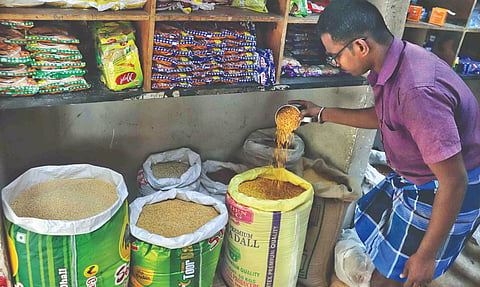

By TINISHA RACHEL SAMUEL, SWEDHA RADHAKRISHNAN
The drastic reduction in rainfall across south India along with the failure of seasonal rains in the Cauvery catchment area and tiger reserves spread over The Nilgiri biosphere is all set to affect the production of agricultural produce and escalate the growing inflation in TN and Andhra, warn stakeholders dealing with groceries, spices, and vegetables.
Though the cost of vegetables is currently stable, prices of other grocery items are slowly inching upwards.
“Earlier, due to intense rainfall in the neighbouring states, crops were damaged, which led to supply shortage. Prices skyrocketed above Rs 100/kg of many vegetables such as tomatoes, beans, green chillies and ginger. Now, the market receives 7,000-8,000 tonnes of vegetables from across the State, Karnataka, Andhra Pradesh and Maharashtra. This dipped the price by 50% compared to the rates sold in the last 3 months,” explained R Muthukumar, a wholesale trader at Koyambedu wholesale market.
But now, due to the drought situation in other states, prices are most likely to go up soon. Traders stated that as perishable commodities were sold at lowest prices, customers and retail vendors bought them in huge quantities.
“The northeast monsoon is likely to commence in October. The rates are expected to increase by 10-20% due to marginal decrease in supply,” said a trader. “For over a decade, the fruit sale was dull due to change in weather conditions. Now, in this monsoon season, they will get worse.”
Price of groceries was very high in 2023, and the poor and middle-class families were the worst affected by it, as even the necessities were unaffordable. The city’s households from the middle and lower classes have been negatively impacted by this predicament.
“The rate of essential commodities has increased by a very large margin. For example, the price of cumin seeds was Rs 10. But now it’s Rs 45 for 50 gm. Even the rate of spices is higher than that of oil, dal, etc. We don’t have a choice but to use cumin or fenugreek seeds. We could compensate for it only if our income increases,” averred Manju Benny, a homemaker.
Everything is expensive now, lamented Rahamadhulla, a wholesaler in Broadway. “Earlier, consumers were not fussy about buying grocery items. Now, they are particular about the cost and quantity. Those who used to buy highcost products are now buying lowcost items only. And, middle-class families are buying products of lesser quality,” he added. “The reason for this price hike is shortage of commodities. For example, Basmati rice comes from Punjab and Haryana. But there’s a shortage in those states, as they didn’t cultivate the crops last year.”
Climate change is also one of the main reasons for the spike in prices of essentials. It has adversely impacted agriculture. “Less rain and excess rain – both affect crops, especially rice. Plus, workers’ wages are also high. All of this forces farmers to shift from farming to something more, as expenditure surpasses income,” pointed out Kurian Abraham, a farmer.
Jyoti Raj, a wholesaler, referred to the price of dals that have increased over the past few months. “Toor dal has increased by Rs 60/kg and moong dal by Rs 10/ kg within 4 months. The price of pepper has risen by Rs 200/kg. Price of cumin seeds has spiked from Rs 400 to Rs 800/kg. The rate of pulses has also increased at a very high rate,” he explained.
According to retired professor Suresh Dhas, the price hike and fluctuation has particularly affected the middle class and lower middle class as employment was shrinking. “And, there is much uncertainty in employment. It’s not possible to cut down on essentials like groceries. Entertainment factors and eating out are the only possible areas they can do cost-cutting. The rich are the only ones benefited from inflation,” he added.
Those who used to buy high-cost products are now buying low-cost items only. And, middle-class families are buying products of lesser quality - Rahamadhulla, a wholesaler in Broadway